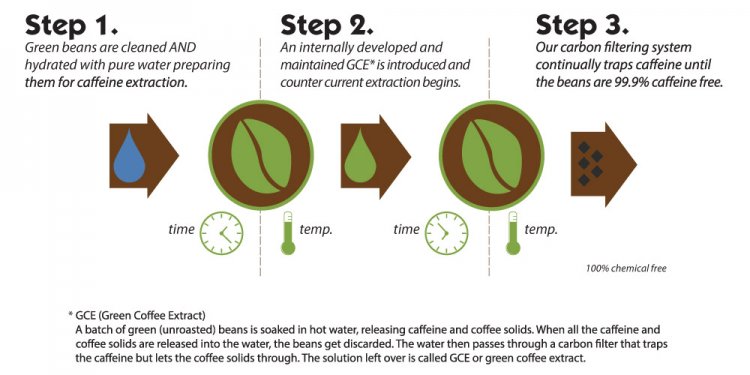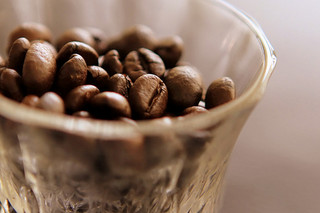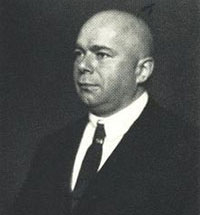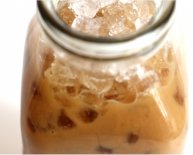
How to make decaf coffee?
 Let’s start with saying the most obvious. Caffeine occurs in coffee naturally, so any method of decaffeination (no matter how good it is) is considered by many aficionados unnatural. Some go but far as claiming that it goes against the normal order of things. However you will find about 10per cent of coffee lovers who wants to enjoy good sit down elsewhere with no moderate stimulating influence of caffeine.
Let’s start with saying the most obvious. Caffeine occurs in coffee naturally, so any method of decaffeination (no matter how good it is) is considered by many aficionados unnatural. Some go but far as claiming that it goes against the normal order of things. However you will find about 10per cent of coffee lovers who wants to enjoy good sit down elsewhere with no moderate stimulating influence of caffeine.
Can it be done? Can you really have actually a GOOD sit down elsewhere that has been subjected to a decaffeination procedure? Read on and work out your very own mind whether it’s possible.
CAVEAT EMPTOR: “decaffeinated” does not mean 100percent caffeinated drinks free. In fact a decaf coffee only needs to be 97% caffeinated drinks free according to the USDA. Meaning that an average 12 oz. cup of decaffeinated coffee, which originally might-have-been filled with 180 mg of caffeine, now only would consist of 5.4 mg of caffeinated drinks.
What All Decaffeination Processes Have As A Common Factor
Before we have a look at any specific decaffeination procedure let’s see what they share in accordance as a bunch.
- Coffee is definitely decaffeinated in its green (unroasted) condition.
- The maximum challenge is always to attempt to split up only the caffeinated drinks through the espresso beans while making one other chemical substances at their particular initial levels. This is simply not effortless since coffee contains somewhere around 1, 000 chemicals that are crucial that you the flavor and aroma with this perfectly complex elixir.
- Since caffeine is a water-soluble compound, liquid is employed in all types of decaffeination.
- However, liquid on it's own isn't the best solution for decaffeination. Liquid is not a “selective” solvent and as a consequence eliminates various other dissolvable substances, like sugars and proteins, along with caffeinated drinks. For that reason all decaffeination procedures make use of a decaffeinating representative (such methylene chloride, triggered charcoal, CO2, or ethyl acetate). These agents assist accelerate the procedure and minimize the “washed-out” results that water alone will have regarding flavor of decaf coffee.
The Roselius Process
1st commercially effective decaffeination procedure had been conceived because of the German coffee vendor in 1903 and patented in 1906. Legend has it that their quest for decaffeinated coffee had been inspired because of the belief that exorbitant coffee drinking had poisoned their daddy.
The “Roslius Process” included steaming espresso beans with a brine answer (i.e., liquid, saturated with sodium) and making use of the natural chemical ingredient benzene as a solvent to extract the caffeinated drinks. This procedure, however, is no longer utilized due to the fact that benzene may be a human carcinogen.
The Four Main Types Of Decaffeination Applied These Days
To keep things well arranged, let’s group the four procedures into two basic categories, each containing two practices.
Solvent-based procedures |
Non-Solvent Based Processes |
|
|
Solvent based processes are those where caffeinated drinks is taken away from beans with the help of a substance solvent, eg methylene chloride or ethyl acetate. Those solvent based processes consequently may be split into practices using the “direct” method versus the “indirect” technique.
In the direct strategy caffeinated drinks is taken away by soaking the materials right in a solvent; the solvent is directly placed on the beans. Conversely, in indirect technique the caffeine-laden water is transferred to a different tank and addressed with a solvent; in this situation the solvent never touches the beans.
 Solvents found in decaffeination
Solvents found in decaffeination
As I’ve mentioned above, the decaffeination of coffee involves the use of a decaffeination agent. In solvent-based processes a chemical solvent is added either directly or indirectly to selectively remove the caffeine.
Given many health scares attached to early efforts in decaffeination (the hit listing of harmful solvents includes: benzene, trichloroethylene (TCE), dichloromethane plus chloroform) the solvents of preference have become methylene chloride and ethyl acetate.
Although methylene chloride (CH2Cl2), aka dichloromethane (in Europe) or MC, is a solvent, its use as a decaffeination agent just isn't considered a wellness threat. Indeed the Food and Drug Administration features determined any potential wellness threat can be so low “as become really non-existent” (Food And Drug Administration, 1985). Although the FDA legislation enables to ten components per million (ppm) residual methylene chloride, real coffee industry rehearse result in levels nearer to one component per million.
Also, while it is possible that traces of this solvent remain in the decaffeinated beans this indicates very unlikely that methylene chloride would endure the roasting process. This colorless liquid is extremely volatile and vaporizes at 104 degrees F. Now if you take under consideration that coffee is roasted at least of 400 levels F for about a quarter-hour, and therefore correct brewing temperature are at about 200 degrees F, it appears unlikely that much if any methylene chloride would result in your cup Java.
Ethyl acetate (CH3CO2C2H5) is hailed by some become much more “natural” than other chemical compounds and safer than methylene chloride as it is out there in min quantities in ripening fruits, such as oranges and blackberries. As this solvent does occur in the wild you’ll often see coffees decaffeinated with this technique called “naturally” decaffeinated.
However, because of the impracticality of gathering natural ethyl acetate and its cost, the chemical used for decaffeination appears to be synthetic. Ethyl acetate is produced commercially from ethyl alcohol and acetic acid, which in turn may be produced from natural ingredients or petroleum derivatives.
Ethyl acetate, like methylene chloride, is quite volatile and therefore the point made above also applies here.
Now that we’ve got a basic framework to utilize let’s have a deeper go through the before-mentioned practices. Since 70percent of coffee is decaffeinated with the help of solvents, I’ll focus on solvent depending processes.
1) The Indirect–Solvent Based Process
In indirect-solvent strategy the coffee beans are wet in almost boiling water for all hours, which extracts the caffeinated drinks along with other taste elements and essential oils through the beans.
Water will be divided and utilized in another tank in which the beans tend to be washed for around 10 hours with either methylene chloride or ethyl acetate. The particles of the chemical solvent selectively bond with the molecules of caffeine therefore the resulting combination is then heated to evaporate the solvent and caffeine.
Lastly, the beans tend to be reintroduced on fluid to reabsorb the majority of the coffee essential oils and flavor elements.
This method is very preferred in European countries, particularly in Germany, and mostly utilizes methylene chloride as solvent. Thus it is also known as “KVW Method” (quick for: Kaffee Veredelugs Werk), “The European Method”, “Methylene Chloride Method”, or “Euro Prep”.
2) The Direct–Solvent Based Process
Inside approach to decaffeination the beans are steamed for approximately 30 minutes being open their particular skin pores. After the espresso beans are receptive to a solvent, they have been over and over repeatedly rinsed with either methylene chloride or ethyl acetate for about 10 hours to get rid of the caffeine. The caffeine-laden solvent will be drained away and beans are steamed once more to get rid of any residual solvent.
Quite often the solvent of choice in this technique is ethyl acetate, therefore you’ll frequently notice it described as “The Natural Decaffeination Process” or “The Ethyl Acetate Method”.

















